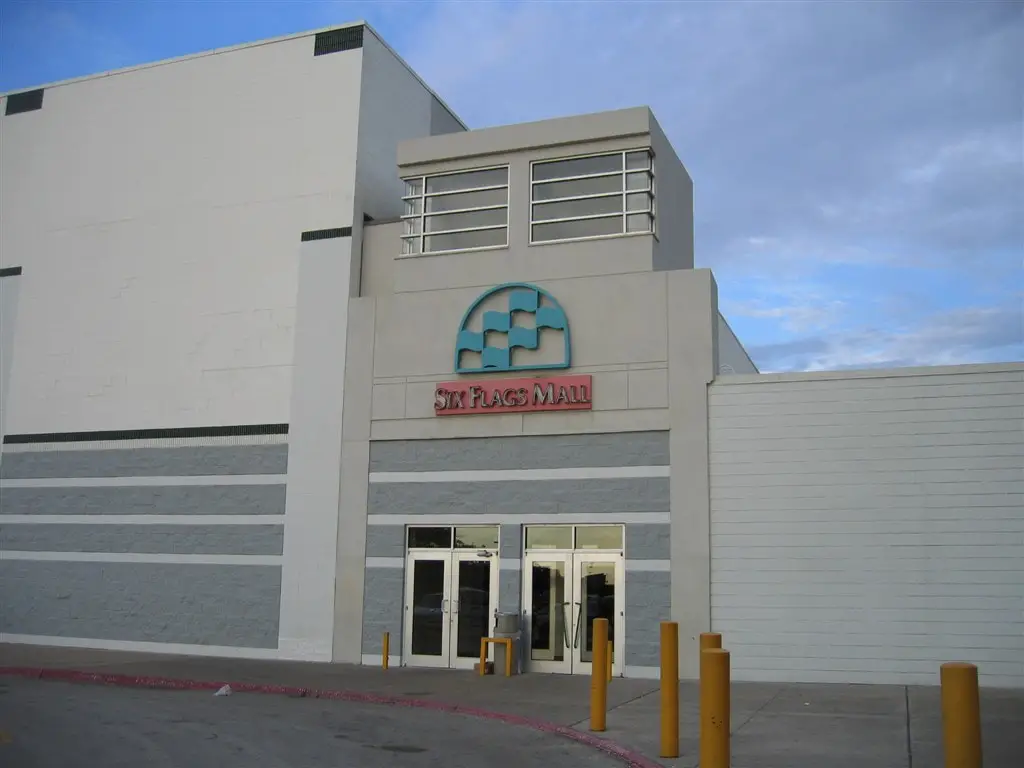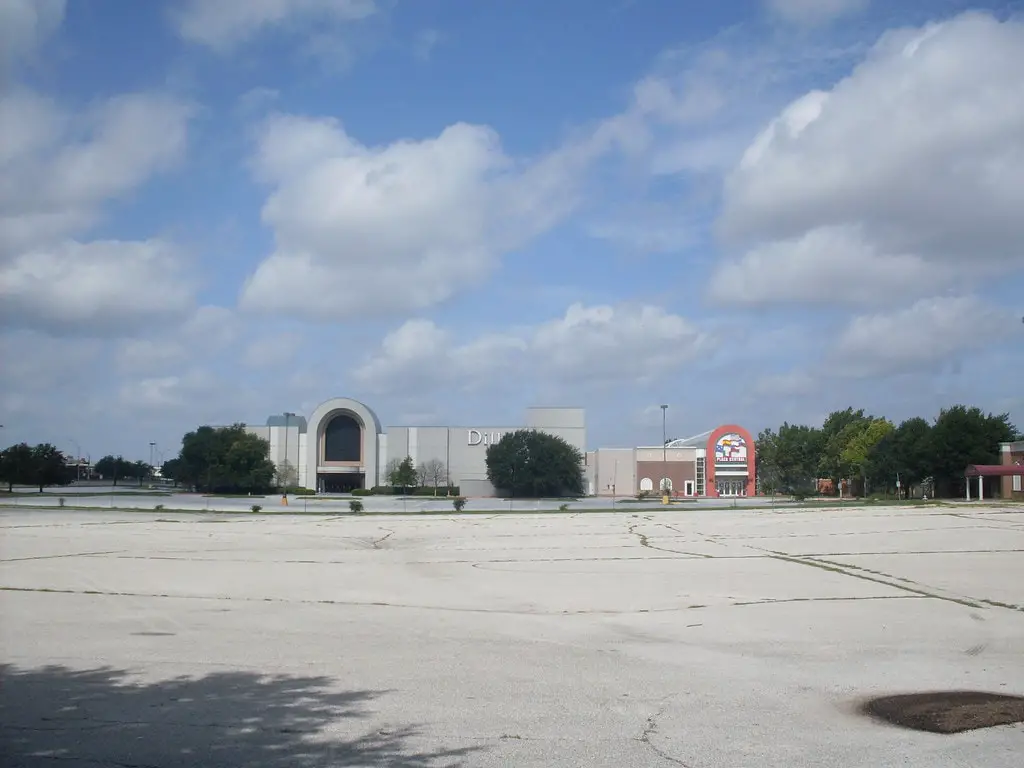The Inception and Rise of Six Flags Mall
The Dawn of a Shopping Era in Arlington
In the heart of Arlington, Texas, a new chapter in retail history began in August 1970 with the opening of Six Flags Mall.
This mall wasn’t just another shopping center but Arlington’s first enclosed mall, marking a significant moment in the city’s commercial landscape.
The mall’s name was a nod to its famous neighbor, near the already popular Six Flags Over Texas theme park.
Its arrival was a game-changer, offering a unique shopping experience that had been absent in the region.
A Trailblazer in Tarrant County
At its opening, Six Flags Mall claimed the title of the largest shopping center in Tarrant County. This wasn’t merely a local achievement but a regional milestone, as it became the first major shopping facility in the area.
Imagine strolling through a vast expanse of retail space, with every store offering something new and exciting.
For residents in and around Arlington, the mall became a symbol of progress and modernity, where shopping blended with experience.
Architectural Marvel and Cultural Hub
The architectural design of Six Flags Mall was more than just functional; it was a statement of style and modernity.
The mall quickly became a cultural hub, attracting shoppers and those looking to immerse themselves in a vibrant community space.
It was a place where families and friends could gather, explore, and create memories. With its unique design and atmosphere, Six Flags Mall stood as a testament to Arlington’s evolving retail and recreation landscape.
Six Flags Mall: A Dominant Force in the Retail Landscape
Six Flags Mall’s Peak Years
Throughout the 1970s and 1980s, Six Flags Mall enjoyed a period of prosperity and dominance in Arlington’s retail scene.
It was a bustling hub where families, teenagers, and shoppers from across the region converged.
USA Quiz
How many questions would you like?
The mall offered various stores, from high-end boutiques to popular chain outlets, catering to multiple tastes and preferences.
It wasn’t just a place to shop but a social venue where people came to meet, eat, and enjoy the day.
The Rise of New Competitors
The late 1980s saw a shift in the retail landscape with the opening of The Parks at Arlington in 1988. This new shopping center brought modernity and an enhanced shopping experience to South Arlington.
The advent of this new mall marked the beginning of a competitive era for Six Flags Mall. Introducing The Parks at Arlington gave local shoppers more options, leading to a gradual shift in consumer preferences.
This competition was a turning point, indicating that the retail market in Arlington was evolving.
Early Signs of Struggle
Entering the 1990s, Six Flags Mall began to show signs of struggle. The closure of the JC Penney store in 1997 was a significant blow, signaling a downturn in the mall’s fortunes.
This closure was more than the loss of a store; it represented a change in the shopping habits and preferences of the local population.
As the mall grappled with these challenges, it became evident that the retail industry was changing, and Six Flags Mall needed to adapt to stay relevant.
The Decline of Six Flags Mall: A Shift in Retail Dynamics
The Departure of Anchor Stores
The early 2000s marked a challenging phase for Six Flags Mall, characterized by the closure of its major anchor stores.
In 2002, Dillard’s and Sears, two of the mall’s key attractions, shut their doors. This was a significant hit to the mall’s foot traffic and appeal.
Attempts at Revival Amidst Growing Challenges
To revive the mall’s allure, Dillard’s reopened as a Clearance Center in 2005, following the closure of Foley’s, the fourth and final anchor store, earlier that year.
This move aimed to attract bargain hunters and retain some of the mall’s customer base. Despite these efforts, the mall continued to face increasing vacancies.
The once bustling corridors began to echo with the quiet of declining patronage, reflecting a broader trend in the retail industry where traditional malls struggled to keep pace with changing consumer habits.
The Erosion of Mall Culture
By this time, the significance of Six Flags Mall had significantly diminished. The increasing number of empty stores painted a stark picture of the mall’s declining relevance.
The erosion of the mall culture that once thrived at Six Flags Mall mirrored a nationwide trend of declining traditional retail spaces, influenced by various factors, including online shopping and changing consumer priorities.

The Final Curtain: Foreclosure and Auction of Six Flags Mall
The Onset of Financial Woes
By 2008, Six Flags Mall faced significant financial challenges, culminating in foreclosure. This development was a stark indicator of the mall’s declining fortunes.
The bustling shopping center of the past was now grappling with an increasingly empty interior, a shadow of its former self.
With only a dozen stores remaining, the mall that once symbolized retail vibrancy in Arlington, Texas, struggled to survive in a rapidly changing retail landscape.
The Mall Goes Under the Hammer
In December 2011, the property was placed up for auction. This event was pivotal, signifying the end of an era for Six Flags Mall.
By this time, the once-thriving mall was reduced to just a few operational stores, including the Dillard’s Clearance Center and the Cinemark Tinseltown 9 movie theater.
The auction represented a significant shift in the mall’s story, from a bustling retail hub to a site searching for a new identity and purpose.
Reflecting on the Mall’s Legacy
The foreclosure and subsequent auction of Six Flags Mall were more than just financial transactions; they were symbolic of the broader changes in the retail industry and consumer habits.
The mall, which had once been a central part of Arlington’s social and economic fabric, was now navigating the uncertainties of an evolving market.

Plaza Central: A Brief Resurgence and Legal Tangles
The Advent of Plaza Central
In December 2012, the landscape of Six Flags Mall took a hopeful turn with the announcement of its transformation into Plaza Central, a Hispanic-oriented shopping center.
This initiative, led by investor G.L. “Buck” Harris, was aimed at revitalizing the former JC Penney anchor store and, by extension, the entire mall.
The vision was to create a vibrant shopping and cultural hub that catered to the local Hispanic community, injecting new life into the aging mall structure.
Zoning Challenges and Legal Hurdles
However, the journey to revitalizing Six Flags Mall was not smooth. Zoning issues with the City of Arlington emerged as significant roadblocks, leading to legal disputes that put the project on hold.
These challenges highlighted the complexities of redeveloping large commercial properties and the importance of navigating municipal regulations.
The legal battles surrounding Plaza Central underscored the difficulties in repurposing former retail giants like Six Flags Mall.
The Short-Lived Rebirth and Final Closure
Despite the challenges, Plaza Central opened its doors in October 2014, marking a new chapter for the beleaguered mall.
However, this revival was short-lived, as the mall closed again a year and a half later. In 2016, demolition began, signaling the definitive end of Six Flags Mall.
The story of Plaza Central is a narrative of ambition, struggle, and the harsh realities of the changing retail landscape.
It serves as a reminder of the difficulties faced in reviving aging retail spaces in an era of rapid commercial evolution.
The Transformation: From Retail Landmark to Industrial Space
The Demolition of a Once-Bustling Mall
The demolition of Six Flags Mall, which began in the summer of 2016, marked the final chapter in the story of this once-iconic shopping center.
The process was not without its challenges, including fires and legal hurdles, but it symbolized the end of an era.
The dismantling of the mall represented the physical and symbolic removal of a once-central piece of Arlington’s retail landscape, making way for new developments and a new chapter in the city’s history.
Industrial Rebirth on Historic Grounds
2018, General Motors (GM) initiated a substantial redevelopment project on the former Six Flags Mall site.
This project, part of a broader $1 billion investment in U.S. operations, aimed to establish a new supplier park and logistics center adjacent to GM’s assembly plant in Arlington.
The result of this initiative is the Arlington Automotive Logistics Center, a sprawling two-building facility encompassing over 1.2 million square feet on an 80-acre area.
This development reflects a strategic move by GM to streamline its supply chain and enhance operational efficiency.
This redevelopment was more than just a change in land use; it represented a shift in the area’s economic focus.
The site, which had once been a hub of retail activity, was now poised to become a center for industrial growth.
The project has created more than 850 jobs in Arlington, with approximately 600 of these roles associated with work previously done outside the U.S.
This influx of jobs represents a significant economic uplift for the community.

Reflecting on Six Flags Mall’s Legacy
As the site of the former Six Flags Mall transformed, it became clear that the legacy of the mall would endure in the memories of those who visited and cherished it.
The story of Six Flags Mall is a vivid illustration of the ever-evolving nature of retail and commercial spaces.
It stands as a reminder of the transient nature of such establishments and the importance of adaptability in the face of changing economic and consumer trends.
The Enduring Impact of Six Flags Mall
The story of Six Flags Mall is a rich tapestry woven into the fabric of Arlington’s history. It was more than a shopping center; it was a landmark that reflected the city’s growth, culture, and changing trends.
The mall’s rise, dominance, struggles, and eventual transformation into an industrial space capture the essence of the evolving retail landscape and its impact on local communities.

